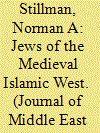| Srl | Item |
| 1 |
ID:
163254


|
|
|
|
|
| Summary/Abstract |
Jews constituted a significant element in the population of the medieval Muslim West, which in the Middle Ages included much of Spain as well as North Africa. They became linguistically arabized by the tenth century and adopted many elements of Islamic general culture. There were, however, limitations—both self-made and imposed by the dominant society. This article discusses the areas of contact and integration they had with Islamic culture, on the one hand, and boundaries of separation and differentiation, on the other.
|
|
|
|
|
|
|
|
|
|
|
|
|
|
|
|
| 2 |
ID:
102825


|
|
|
|
|
| Publication |
2011.
|
| Summary/Abstract |
This article explores the different scalar dimensions of Berber masquerades in southeastern Morocco. By ritually performing Jewish characters and demonstrating philo-Semitic nostalgia for a former Jewish presence, Berber (Amazigh) activists simultaneously engage different audiences at a local, national and transnational scale. In the first place, they assert themselves as moderate (even secular) Muslims for a transnational audience for whom Muslims' supposed anti-Semitism has been a mode of excluding them from modernity. At the same time, their performances underline the specificity of Berber culture as part of a national folkloric archive, welcome to a Moroccan national state interested in forging an authentic, national Islamic practice distinct from pan-Islamic Wahhabism. Thirdly, in allying themselves with Jews, Berber activists distance themselves from a variety of rivals to local political and economic dominance, particularly black "Haratin" whose demographic and economic strength in the southeastern oases has increased since Moroccan independence. In exploring the confluences and contradictions between these different scales of activism, this article points to the internal fractures within social movements organised around religion or ethnicity.
|
|
|
|
|
|
|
|
|
|
|
|
|
|
|
|